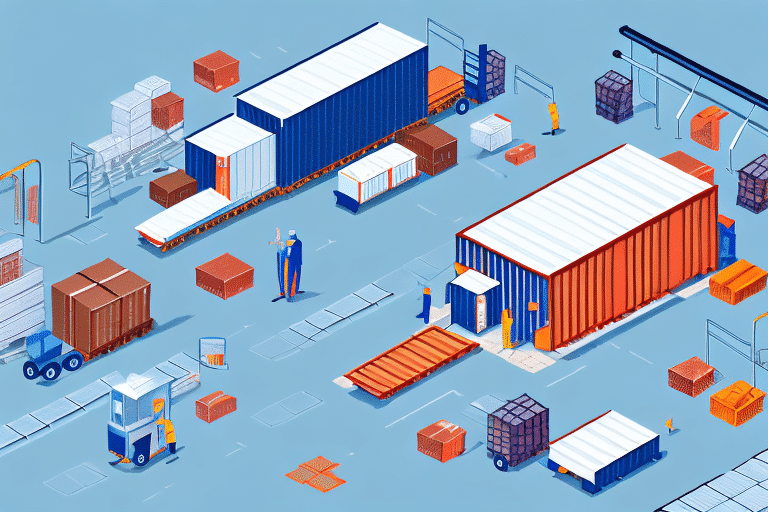Understanding the Basics of 3PL E-Commerce
Third-party logistics (3PL) involves outsourcing logistics and supply chain activities to specialized providers. In the context of e-commerce, 3PL providers manage critical operations such as warehousing, transportation, order processing, shipping, returns, and customer service. By leveraging 3PL services, businesses can focus on their core competencies while ensuring efficient and reliable logistics management.
According to a 2023 Statista report, the global 3PL market is expected to reach over $1 trillion by 2025, highlighting the increasing reliance of businesses on outsourced logistics solutions.
Benefits of Outsourcing E-Commerce Logistics to a 3PL Provider
Outsourcing e-commerce logistics to a 3PL provider offers numerous advantages:
- Access to Advanced Technology: 3PL providers utilize state-of-the-art warehouse management systems (WMS) and transportation management systems (TMS) to optimize logistics operations.
- Cost Savings: By leveraging economies of scale, 3PL providers can reduce shipping costs and minimize overhead expenses associated with maintaining in-house logistics.
- Scalability: 3PL services allow businesses to scale their operations seamlessly during peak seasons or unexpected surges in demand without significant capital investment.
- Improved Customer Service: With efficient order fulfillment and reliable shipping, businesses can enhance customer satisfaction and loyalty.
Research from the Inbound Logistics indicates that 60% of companies outsource their logistics to improve service quality and operational efficiency.
How to Choose the Right 3PL Provider for Your E-Commerce Business
Selecting the appropriate 3PL provider is crucial for the success of your e-commerce operations. Consider the following factors:
- Industry Expertise: Ensure the provider has experience in the e-commerce sector and understands the unique challenges it presents.
- Reputation and Reliability: Research client testimonials and case studies to assess the provider’s track record.
- Technology Integration: The provider should offer seamless integration with your existing systems, such as your e-commerce platform and inventory management software.
- Geographical Coverage: Evaluate the provider’s distribution network to ensure they can efficiently handle your shipping regions.
- Cost Structure: Understand the pricing model and ensure it aligns with your budget and expected service levels.
The Forbes Technology Council recommends conducting thorough due diligence and requesting detailed proposals to make an informed decision.
The Role of Technology in 3PL E-Commerce Solutions
Technology is at the heart of modern 3PL e-commerce solutions, enabling real-time visibility, automation, and seamless integration across the supply chain. Key technological components include:
- Warehouse Management Systems (WMS): Optimize inventory storage, picking, and packing processes.
- Transportation Management Systems (TMS): Plan, execute, and track the movement of goods efficiently.
- Order Management Systems (OMS): Streamline order processing from multiple sales channels.
- Data Analytics: Provide actionable insights into customer behavior, inventory levels, and supply chain performance.
According to a McKinsey & Company report, companies that leverage advanced logistics technology can reduce operational costs by up to 20% while improving service levels.
Streamlining Order Fulfillment with 3PL E-Commerce Services
Efficient order fulfillment is critical for e-commerce success. 3PL providers offer various services to streamline this process:
- Pick and Pack: Accurately selecting and packaging products for shipment.
- Kitting: Assembling multiple products into a single package to meet specific customer orders.
- Labeling and Packaging: Ensuring products are properly labeled and packaged to prevent damage during transit.
- Inventory Management: Maintaining optimal inventory levels to avoid stockouts and overstock situations.
Implementing an efficient order fulfillment system can lead to faster delivery times, reduced errors, and enhanced customer satisfaction, as highlighted in a Supply Chain Dive article.
Maximizing Efficiency and Minimizing Costs with 3PL E-Commerce Solutions
3PL solutions are designed to enhance operational efficiency and reduce costs through:
- Optimized Inventory Management: Real-time tracking and forecasting to maintain optimal stock levels.
- Automated Processes: Reducing manual interventions to minimize errors and speed up operations.
- Negotiated Shipping Rates: Leveraging bulk shipping to secure discounted rates from carriers.
- Lean Operations: Streamlining workflows to eliminate waste and improve productivity.
Data from the Business Insider indicates that businesses using 3PL services can achieve up to a 30% reduction in logistics costs.
Overcoming Common Challenges in 3PL E-Commerce Logistics
While 3PL services offer numerous benefits, they also come with challenges:
- Inventory Visibility: Ensuring accurate and real-time tracking of inventory across multiple channels.
- Managing Returns: Handling product returns efficiently to maintain customer satisfaction.
- Shipping Coordination: Coordinating shipments across various carriers and destinations to ensure timely delivery.
- Communication: Maintaining clear and consistent communication between the business and the 3PL provider.
Effective collaboration and the use of integrated technology solutions can help mitigate these challenges, as discussed in a Harvard Business Review article.
Case Studies: Real-Life Examples of Successful Implementations of 3PL E-Commerce Solutions
Real-world examples demonstrate the tangible benefits of partnering with 3PL providers:
Online Pet Food Retailer
A leading online pet food retailer partnered with a 3PL provider to manage its logistics. The collaboration resulted in a 25% reduction in shipping costs and a 99.5% on-time delivery rate, significantly enhancing customer satisfaction and retention.
High-End Fashion Retailer
A high-end fashion brand outsourced its returns management to a 3PL provider, cutting processing time by 50%. This improvement streamlined operations and increased overall efficiency.
Home Goods Retailer
A home goods company implemented a real-time inventory management system through its 3PL partner. This led to a 30% increase in sales and a 20% reduction in order processing time by minimizing stockouts and enhancing order accuracy.
Beauty Products Retailer
A beauty products company expanded its global reach by partnering with a 3PL provider. The provider navigated international shipping regulations and established localized fulfillment centers, resulting in a 50% increase in international sales and a 40% reduction in shipping costs.
Future Trends and the Evolution of 3PL E-Commerce Solutions
The 3PL e-commerce landscape is continually evolving, driven by technological advancements and changing market demands. Key trends include:
- Artificial Intelligence (AI) and Machine Learning: AI-driven solutions are optimizing operations by predicting demand, enhancing inventory management, and personalizing customer experiences.
- Sustainability Initiatives: 3PL providers are increasingly focusing on eco-friendly practices, such as using alternative fuels, optimizing transportation routes, and reducing packaging waste to minimize their carbon footprint.
- Automation and Robotics: The adoption of automated systems and robotics in warehouses is improving efficiency and reducing labor costs.
- Omni-Channel Fulfillment: Providing seamless fulfillment across various sales channels, including online, mobile, and physical stores, to meet diverse consumer expectations.
As highlighted in a Forbes article, these trends are set to shape the future of 3PL e-commerce solutions, enabling businesses to stay competitive in a rapidly evolving market.
In conclusion, partnering with a 3PL provider offers e-commerce businesses the opportunity to streamline operations, reduce costs, and enhance customer satisfaction. By carefully selecting a reliable and technologically adept 3PL partner, businesses can achieve sustainable growth and maintain a competitive edge in the dynamic world of e-commerce.






















